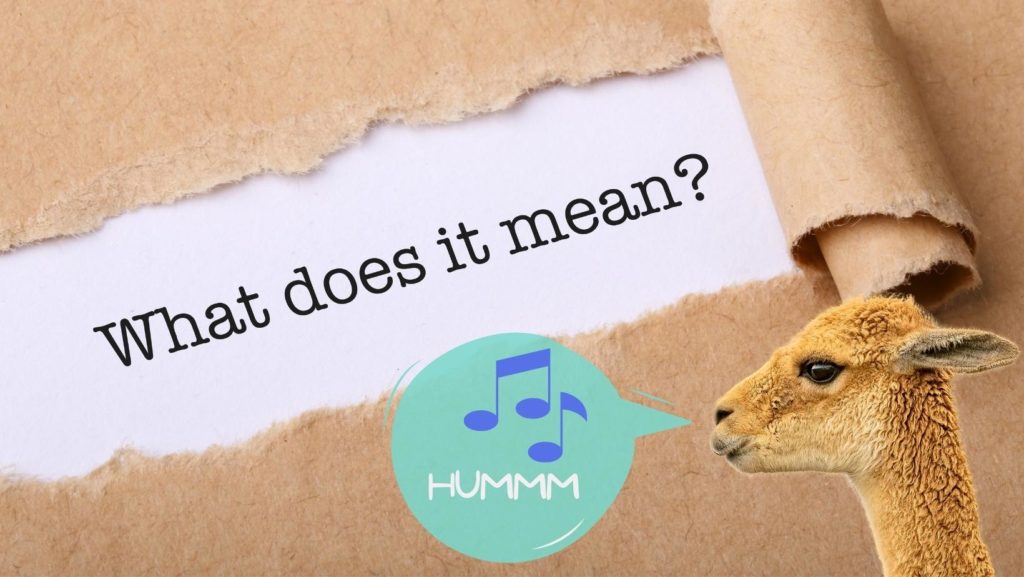
If you provide care for camelids (in this resource, the term camelid(s) is only referring to llamas and alpacas) at your sanctuary, then it is helpful to understand their vocalizations! Vocalizations can provide vital insight into a resident’s emotional state and health if you are able to interpret them properly. They can provide context to body language and behavior, allowing you to identify possible health issues, understand herd dynamics, and how a resident may feel about you, your presence, your behaviors, and their comfort during events such as transportation, moving into new spaces, changes in herds, and procedures they may have to undergo. This resource is a glossary of the possible vocalizations you may hear a llama or alpaca resident make. We hope this resource will help you better understand your camelid residents, allowing you to provide them with the best care possible. This resource is most helpful when read in conjunction with our resources on camelid body language, ears, and tails.
Vocalization Glossary For Camelids
While body language makes up the majority of communication with our camelid friends, vocalizations are another important way camelid residents may express themselves. Understanding a resident’s vocalizations can better assist you in assessing their emotional states and in identifying social relationships between other camelid residents, as well as identifying health issues. Sometimes vocalizations can also tell you a lot about a resident’s comfort level around different individuals and during different situations. This allows caregivers to tailor these situations and their own behaviors to better meet the needs of the individual better. All of these vocalizations (and body cues) are an opportunity for care staff to provide individualized care that promotes health, trust, strong relationships, and overall content residents. Now let’s take a look at the fascinating vocalizations camelid residents can make!



Everyone Is An Individual
While this resource contains generalized descriptions of common vocalizations of camelids, everyone is different and some individuals may have a lower or higher pitch naturally or tend towards squeakier or more gurgling-type sounds than someone else. Be sure to learn all you can about each individual so you have a good idea of what their “normal” is. This will allow you to better ascertain what they are expressing and how to move forward.
Non-Compassionate Videos Below
We have included links to examples of the various vocalizations you might encounter when caring for llamas and alpacas. These videos provide examples of vocalizations in a variety of settings, a few, while not graphic, are clearly taken in non-compassionate contexts, such as in agricultural fairs or farm settings. The Open Sanctuary Project does not condone or endorse the exploitationExploitation is characterized by the abuse of a position of physical, psychological, emotional, social, or economic vulnerability to obtain agreement from someone (e.g., humans and nonhuman animals) or something (e.g, land and water) that is unable to reasonably refuse an offer or demand. It is also characterized by excessive self gain at the expense of something or someone else’s labor, well-being, and/or existence. of any being, human or nonhuman, and has only included these links as we feel residents will be best served if care staff are thoroughly familiar with the general sounds camelids make. If you are a sanctuary and have a video of camelid residents vocalizing, please reach out to us, as we always prefer to highlight compassionate sources!
Alarm Call
If a resident is alarmed, they may sound an alarm to other members of their herd. This can sound like a staccato (short, sharp, separated sounds) braying, high-pitched, and squeaky.
Here is an example of a llama making an alarm call:
Here is another example, this one is of Canela, an alpaca, making an alarm call:
Bruxism (Teeth Grinding)
While teeth grinding isn’t a vocalization, it is a sound to listen for as it can indicate pain or discomfort in residents.
Clicking
Clicking sounds from camelids sound similar to clicking sounds humans make with their tongues against the roof of their mouths. This vocalization may be indicative of mild displeasure or a greeting, a “back off” or “hello”, so to speak. A mother may also “cluck” when concerned about or calling her cria.
Here is an example of an alpaca, Colleen, making a clicking sound in response to a human making a clicking sound with their tongue:
https://youtube.com/shorts/ZUYvMsG3KKw?feature=share
Here is an example of a mother “clucking” to her criaA young llama or alpaca (turn up the volume and listen closely):
https://youtube.com/shorts/olUHsbi9Iy0?feature=share
Groaning/Moaning
Groaning or moaning can be a sign the resident is feeling unwell or is in pain. If you hear this, be sure to do a quick assessment of their general health and look for any sign of injury or illness.
Here is an example of a llama moaning and itching their ear. They may not be feeling well, or they may be otherwise displeased or distressed by their situation:
https://youtube.com/shorts/6r06cwnH_qU?feature=share
Growling
A deep-throated growl can indicate an unhappy, annoyed, or angry camelid resident.
Here is an example of both screeching (see below) and growling coming from angry llamas in a territorial dispute:
Grumbling
Grumbling can be indicative of displeasure, particularly as a warning to other camelids when they are approaching someone when there is food involved.
Here is an example of two male llamas, George and Bucky, making deep humming, grumbling sounds likely expressing displeasure about access to treats. You can see their ears are back and George’s tail is lifted in displeasure:
Another example of grumbling irritated camelids, in this case, alpacas:
Humming
Humming is the most common vocalization in camelids and can have many meanings and purposes depending on the context of a situation. It can convey a number of emotional states, depending on the tone and the pitch. It can convey contentedness, questioning, distress, annoyance, relief, or tension! Humming can be a way camelids “check-in” with one another, or as a way to express displeasure or concern in a situation. Humming can also be relaxed and convey a level of contentment, among other things. You will have to pay close attention to the context of a situation, as well as what their body language is telling you, in order to interpret the meaning.
Here is an example of a mother and cria (alpacas) “talking” to one another through hums:
Here is an example of a cria who is being weaned by being separated from their mother. Notice a difference? This can be a “Where are you? I don’t like this” vocalization:
Luna the llama is making a humming vocalization because she wants breakfast. This could indicate mild displeasure, as in, “I am hungry and don’t like that I don’t have my breakfast. Where is my breakfast?” Which, along with noticing her ears that are somewhat laid back, is a reasonable interpretation:
This is an example of a distressed hum from an alpaca at what appears to be an agricultural “showing” where they have been transported and placed in a small pen surrounded by unknown camelids and humans with loud sounds:
Orgling
Okay, you aren’t likely to find this word in any dictionary, but “orgling” is the sound male camelids make during copulation, and they may even make the sound while chasing females in an attempt to mate. This vocalization is characterized by a rhythmic grunt that expels a burst of air. Depending on the individual, it may be loud or quieter, deeper or squeaker in pitch.
Here is an example of orgling during mating:
Screaming
Screaming is indicative of extreme fear. Some residents may find certain procedures frightening and scream, or they may scream if they are being chased. Recognizing this fear can help your care team better approach situations in order to reduce fear and promote positive emotional states.
Here is an example of the sound of an alpaca screaming:
Squealing
Squealing is indicative of upset, annoyance, or growing fearful emotive states, particularly in the context of someone invading their space. You might hear this sound when someone is upset about being handled, groomed, or approached. We are including squealing as it can certainly indicate upset or fear, but lacks the extreme fear associated with a scream. A squeal may very well turn into a scream if the resident becomes really frightened or the behavior/actions causing the annoyance or fear continue.
Here is an example of an alpaca who is upset about being contained and having a human in her space. As you can see, her ears are back and she is upset, but not exhibiting the extreme fear usually associated with screaming:
Screeching
Screeching in camelids is different than screaming and is more indicative of anger than fear. It is characterized by a loud squealing, gargling sound. You may hear screeching if two male residents are experiencing territorial discomfort or are engaged in a confrontation with another resident, particularly another male resident.
Here is an example of a llama who is “angry”, or feels the horse that has newly moved into the neighboring living spaceThe indoor or outdoor area where an animal resident lives, eats, and rests. is a threat and requires offensive action:
Here is an example of screeching while two male alpacas confront one another:
Snorting
A snort is characterized by a short exhalation of air through the mouth with the mouth generally being loose. It is indicative of mild displeasure and telling someone to leave them alone.
Here is an example of a snorting female alpaca who is not interested in the advances of a male alpaca. You can hear her mate humming in displeasure in the background as another male exhibits mating behaviors towards his mate:
Here is another example of snorting where two alpacas are annoyed with one another and want the other to back off:
We hope this resource has helped you better understand and communicate with your camelid residents!
SOURCES:
The Healthy Alpaca | NADIS Animal Health Skills (Non-Compassionate Source)
Medicine And Surgery Of Camelids | Academia (Non-Compassionate Source)
Alpaca And Llama Behavior | University Of California Davis (Non-Compassionate Source)
Veterinary Treatment Of Alpacas And Llamas | Graham R. Duncan (Non-Compassionate Source)
Gastrointestinal Surgery In Alpacas And Llamas | Veterinary Clinics Of North America: Food Animal Practice (Non-Compassionate Source)
If a source includes the (Non-Compassionate Source) tag, it means that we do not endorse that particular source’s views about animals, even if some of their insights are valuable from a care perspective. See a more detailed explanation here.








